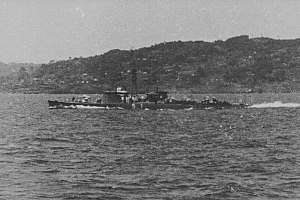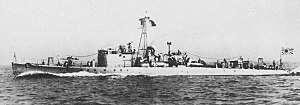No.251-class auxiliary submarine chaser
 Auxiliary Submarine Chaser No.251 in 1938 | |
| Class overview | |
|---|---|
| Name: |
|
| Builders: |
|
| Operators: |
|
| Built: | 1936 – 1939 |
| In commission: | 1937 – 1945 |
| Planned: | 3 |
| Completed: | 3 |
| Retired: | 3 |
 Auxiliary Submarine Chaser No.253 in 1937 | |
| General characteristics | |
| Type: | Submarine chaser |
| Displacement: | 170 long tons (173 t) standard |
| Length: | 45.0 m (147 ft 8 in) overall |
| Beam: | 4.80 m (15 ft 9 in) |
| Draught: |
|
| Propulsion: | |
| Speed: | 23.0 knots (26.5 mph; 42.6 km/h) |
| Range: | 800 nmi (1,500 km) at 14 kn (16 mph; 26 km/h) |
| Complement: | 41 |
| Armament: |
|
The No.251 class auxiliary submarine chaser (第二百五十一号型駆潜特務艇, Dai 251 Gō-gata Kusen-Tokumutei)[1] was a class of submarine chasers of the Imperial Japanese Navy (IJN), serving during World War II. 3 vessels were built in 1936 – 1939 under the Maru 2 Programme. They have two sub classes, this article handles them collectively.
Background
- In 1934, the IJN planned an experimental model of high-speed coast defense submarine chaser. The IJN wanted over 20 kn (23 mph; 37 km/h), however the Navy Technical Department (Kampon) have not designed such a small-sized and high-powered diesels yet.
- The IJN ordered hull design to the Thornycroft, and high-powered diesel design to the MAN, for study a small-sized high-speed boat.
Design
- The Thornycroft drawings were not able to satisfy the IJN, because their designs center of gravity was too high, and bad drainage. The Kampon made a based on the Hayabusa class torpedo boat and finished hull designs.
- The IJN was satisfied with MAN diesel specifications, however their designs were very complicated and very high-prices. The IJN bought two diesels and named MAN Mk.1 diesel (マ式1号ディーゼル, Ma-Shiki 1 Gō diesel). Furthermore, the IJN ordered a copy of this diesel to the Kawasaki Heavy Industries and Mitsubishi Heavy Industries.
- Also, 1 vessel was equipped with a Kampon turbine, because diesel engine was unsuitable for a mass production.
Service
- The IJN deployed them to a mine warfare school after having finished their examination, because they were too small.
- They became a training ship of the mine warfare school, and they acted in Tokyo Bay.
Ships in classes
No.251-class
- Project number K5A. 2 vessels were completed. They were equipped with MAN design diesels. The No.252 was equipped the copied MAN diesels by Kawasaki and Mitsubishi.
No.251
- 14 December 1936: Laid down as the Submarine Chaser No.51 (第51号駆潜艇, Dai 51 Gō Kusentei) at Nihon Kōkan, Tsurumi Shipyard.
- 9 June 1937: Launched.
- 30 September 1937: Completed.
- 15 November 1940: Classified to the Auxiliary submarine chaser, and renamed Auxiliary Submarine Chaser No.51 (第51号駆潜特務艇, Dai 51 Gō Kusen-Tokumutei).
- (after): Assigned to the mine warfare school (Kurihama).
- 30 April 1943: Renamed Auxiliary Submarine Chaser No.251 (第251号駆潜特務艇, Dai 251 Gō Kusen-Tokumutei).
- 28 August 1944: Classified to the Support vessel (tugboat), and renamed No.1658 (公称第1658号, Kōshō-Dai 1658 Gō).
- August 1945: The end of war at Uraga, later nothing more was heard.
No.252
- 14 December 1936: Laid down as the Submarine Chaser No.52 (第52号駆潜艇, Dai 52 Gō Kusentei) at Nihon Kōkan, Tsurumi Shipyard.
- 25 August 1937: Launched.
- 25 July 1939: Completed.
- 15 November 1940: Classified to the Auxiliary submarine chaser, and renamed Auxiliary Submarine Chaser No.52 (第52号駆潜特務艇, Dai 52 Gō Kusen-Tokumutei).
- (after): Assigned to the mine warfare school (Kurihama).
- 30 April 1943: Renamed Auxiliary Submarine Chaser No.252 (第252号駆潜特務艇, Dai 252 Gō Kusen-Tokumutei).
- 15 February 1944: Classified to the Support vessel (tugboat), and renamed No.1650 (公称第1650号, Kōshō-Dai 1650 Gō).
- August 1945: The end of war at Uraga, later nothing more was heard.
No.253-class
- Project number K5B. 1 vessels was completed. She was equipped with Kampon turbine. She was classed in the No.251-class in the IJN official documents.
No.253
- 9 January 1937: Laid down as the Submarine Chaser No.53 (第53号駆潜艇, Dai 53 Gō Kusentei) at Ōsaka Iron Works, Sakurajima Factory.
- 15 July 1937: Launched.
- 31 October 1937: Completed.
- 15 November 1940: Classified to the Auxiliary submarine chaser, and renamed Auxiliary Submarine Chaser No.53 (第53号駆潜特務艇, Dai 53 Gō Kusen-Tokumutei).
- (after): Assigned to the mine warfare school (Kurihama).
- 30 April 1943: Renamed Auxiliary Submarine Chaser No.253 (第253号駆潜特務艇, Dai 253 Gō Kusen-Tokumutei).
- 15 February 1944: Classified to the Support vessel (tugboat), and renamed No.1651 (公称第1651号, Kōshō-Dai 1651 Gō).
- August 1945: The end of war at Uraga.
- August 1946: Sink by unknown effect.
Footnotes
- ↑ At first No.51 class submarine chaser (第五十一号型駆潜艇, Dai 51 Gō-gata Kusentei), until 15 November 1940.
Bibliography
- Ships of the World special issue Vol.45, Escort Vessels of the Imperial Japanese Navy, "Kaijinsha". , (Japan), February 1996
- The Maru Special, Japanese Naval Vessels No.49, Japanese submarine chasers and patrol boats, "Ushio Shobō". (Japan), March 1981
This article is issued from
Wikipedia.
The text is licensed under Creative Commons - Attribution - Sharealike.
Additional terms may apply for the media files.